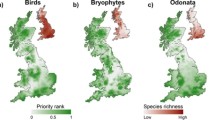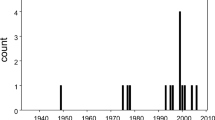Abstract
Habitat loss is major factor in the endangerment and extinction of species around the world. One promising strategy to balance continued habitat loss and biodiversity conservation is that of biodiversity offsets. However, a major concern with offset programs is their consistency with landscape-level conservation goals. While merging offset polices and landscape-level conservation planning is thought to provide advantages over a traditional disconnected approach, few such landscape-level conservation-offset plans have been designed and implemented, so the effectiveness of such a strategy remains uncertain. In this study, we quantitatively assess the conservation impact of combining landscape-level conservation planning and biodiversity offset programs by comparing regions of San Diego County, USA with the combined approach to regions with only an offset program. This comparison is generally very difficult due to a variety of complicating factors. We overcome these complications and quantify the benefits to rare and threatened species of implementing a combined approach by assessing the amount of each species’ predicted distribution, and the number of documented locations, conserved in comparison to the same metric for areas with an offset policy alone. We found that adoption of the combined approach has increased conservation for many rare species, often 5–10 times more than in the comparison area, and that conservation has been focused in the areas most important for these species. The level of conservation achieved reduces uncertainty that these species will persist in the region into the future. This San Diego County example demonstrates the potential benefits of combining landscape-level conservation planning and biodiversity offset programs.



Similar content being viewed by others
References
Alagona PS, Pincetl S (2008) The Coachella Valley multiple species habitat conservation plan: a decade of delays. Environmental Management 41:1–11
Audubon (1997) Report of the National Audubon Society task force on habitat conservation plans. National Audubon Society, Washington, DC
Boykin KG et al (2007) Predicted animal habitat distributions and species richness, Chap. 3. In: Prior-Magee JS et al (eds) Southwest Regional Gap Analysis Final Report. U.S. Geological Survey, Gap Analysis Program, Moscow, ID, pp 679–750
Burgin S (2008) BioBanking: an environmental scientist’s view of the role of biodiversity banking offsets in conservation. Biodiversity and Conservation 17:807–881
Conservation Biology Institute (2004) Las Californias binational conservation initiative: a vision for habitat conservation in the border region of California and Baja California. Conservation Biology Institute, San Diego, CA, 43 pp
County of San Diego (1997) Multiple species conservation program: county if San Diego subarea plan. County of San Diego, San Diego, CA, 156 pp
County of San Diego (2009) Guidelines for determining significance, 3rd revision. County of San Diego, San Diego, CA, 61 pp
Dobson AP, Rodriguez JP, Roberts WM, Wilcove DS (1997) Geographic distribution of endangered species in the United States. Science 275:550–553
Harding EK, Crone EE, Elderd BD, Hoekstra J, McKerrow AJ, Perrine JD, Rissler LJ, Stanley AG, Walters EL, NCEAS HCP Working Group (2001) The scientific foundations of habitat conservation plans: a quantitative assessment. Conservation Biology 15:488–500
Hood LC (1998) Frayed safety nets: conservation planning under the Endangered Species Act. Defenders of Wildlife, Washington, DC
Kareiva P et al (1999) Using science in habitat conservation plans. American Institute of Biological Sciences, Washington, DC
Kiesecker JM, Copeland H, Pocewicz A, McKenney B (2009) Development by design: blending landscape level planning with the mitigation hierarchy. Frontiers in Ecology and the Environment. doi:10.1890/090005
Margules CR, Pressey RL (2000) Systematic conservation planning. Nature 405:243–253
McKenney B, Kiesecker JM (2010) Policy development for biodiversity offsets: a review of offset frameworks. Environmental Management 45:165–176
Morrison ML (2000) Facilitating development of multiple-species conservation reserves and habitat conservation plans: a synthesis of recommendations. Environmental Management 26:S3–S6
Myers N, Mittermeier RA, Mittermeier CG, da Fonseca GAB, Kent J (2000) Biodiversity hotspots for conservation priorities. Nature 403:853–858
Norton DA (2009) Biodiversity offsets: Two New Zealand case studies and an assessment framework. Environmental Management 43:698–706
Penrod K, Cabañero C, Beier P, Luke C, Spencer W, Rubin E (2006) South coast missing linkages project: a linkage design for the Peninsular-Borrego connection. South Coast Wildlands, Idyllwild, CA
Rahn M, Doremus H, Diffendorfer J (2006) Species coverage in multispecies habitat conservation plans: where’s the science? BioScience 56:613–619
Schipper J et al (2008) The status of the world’s land and marine mammals: diversity, threat, and knowledge. Science 322:225–230
Shilling F (1997) Do habitat conservation plans protect endangered species? Science 276:1662–1663
South Coast Wildlands (2008) South coast missing linkages: a wildland network for the south coast ecoregion. South Coast Wildlands, Fair Oaks, CA 67 pp
Stuart SN, Chanson JS, Cox NA, Young BE, Rodrigues ASL, Fischman DL, Waller RW (2004) Status and trends of amphibian declines and extinctions worldwide. Science 306:1783–1786
ten Kate K, Bishop J, Bayon R (2004) Biodiversity offsets: views, experience, and the business case. IUCN Gland, Switzerland and Cambridge, UK, and Insight Investment, London, UK 95 pp
Thomas CW (2001) Habitat conservation planning: certainly empowered, somewhat deliberative, questionably democratic. Politics and Society 29:105–130
U.S. Fish and Wildlife Service (USFWS) (2009) Number of approved HCPs in the United States. http://ecos.fws.gov/conserv_plans/public.jsp. Accessed 5 June 2009
U.S. Fish and Wildlife Service (USFWS), National Marine Fisheries Service (NMFS) (1996) Habitat conservation planning handbook. U.S. Department of Interior, Washington, DC
Wilcove DS, Rothstein D, Dubow J, Phillips A, Losos E (1998) Quantifying threats to imperiled species in the United States. BioScience 48:607–615
Wilhere GF (2002) Adaptive management in habitat conservation plans. Conservation Biology 16:20–29
Wilhere GF (2009) Three paradoxes of habitat conservation plans. Environmental Management 44:1089–1098
Acknowledgments
We acknowledge funding provided by the County of San Diego for this study and the assistance of Melanie Casey (San Diego County GIS) in collecting and analyzing the data. We also thank Leann Carmichael, David Mayer, Michelle Moreno, Tom Oberbauer, Sabrina Ozturk, Randy Rodriguez, Bobbie Stephenson, Susan Wynn, and other county, state, federal, and community group personnel for their guidance on the San Diego County Multiple Species Conservation Program. Finally, we thank Luis Bojorquez-Tapia, Atte Moilanen, and two anonymous reviewers for helping to improve this article.
Author information
Authors and Affiliations
Corresponding author
Rights and permissions
About this article
Cite this article
Underwood, J.G. Combining Landscape-Level Conservation Planning and Biodiversity Offset Programs: A Case Study. Environmental Management 47, 121–129 (2011). https://doi.org/10.1007/s00267-010-9589-9
Received:
Accepted:
Published:
Issue Date:
DOI: https://doi.org/10.1007/s00267-010-9589-9




